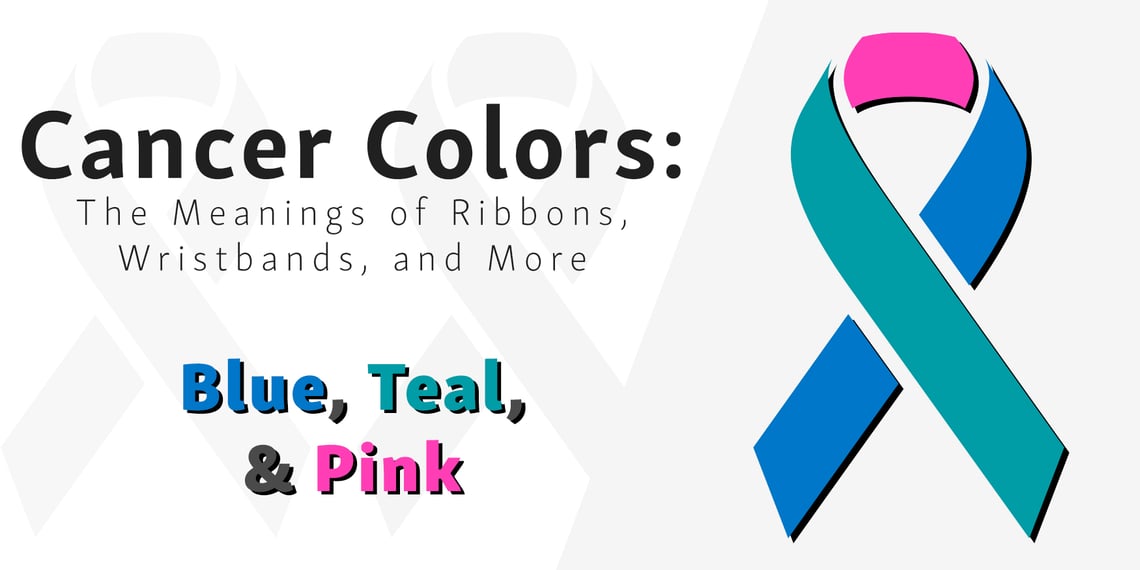
It’s daunting to experience difficulty in breathing, swallowing, or enduring pain in your neck.
For most, these symptoms dissipate. But for those living with thyroid cancer, this is an everyday reality. When you or someone you love has this disease, knowing what to expect can help.
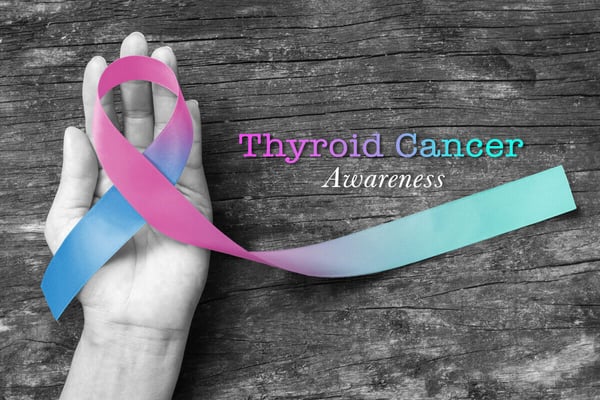 What is Thyroid Cancer?
What is Thyroid Cancer?
Thyroid cancer emerges from the cells of a butterfly-shaped gland found below the Adam's apple.
This gland is crucial, regulating heart rate, blood pressure, temperature, weight, and metabolism. It's essential to ensure its health.
Though thyroid cancer isn't as common as some other forms of cancer, it can be effectively treated, particularly if caught early. In recent years with the advent of improved technology, cancer diagnosis rates have surged, thanks to the ability to detect even minute tumors.
What Causes Thyroid Cancer?
Thyroid cancer is linked with a number of conditions but the exact cause of most types of this cancer is unknown.
Like other cancers, there are several types of factors that make a person more likely to develop this disease.
Factors That Cannot Be Changed
AGE AND GENDER
For unclear reasons, thyroid gland cancers occur three times more often in women than men. It can occur at any age, but the risks peak earlier for women (40s or 50s) than men (60s or 70s). (1)
HEREDITARY CONDITIONS
Several inherited conditions have been linked to different types of thyroid cancer.
Most men and women who develop this cancer do not have an inherited condition or a family history of the disease. Some possible genetic factors include:
-
Familial medullary thyroid carcinoma (FMTC)
-
Familial adenomatous polyposis (FAP)
-
Cowden disease
-
Carney complex, type I
-
Familial nonmedullary carcinoma
FAMILY HISTORY
Having an immediate family member (parent, brother, sister) with thyroid cancer, even with no hereditary factors, increases your chance to develop thyroid cancer.
The genetic basis is unclear at this time. (1)
Risk Factors That Can Be Changed
More good news! Although these are still harmful, it can be easily avoidable.
A DIET LOW IN IODINE
Follicular thyroid cancers are more common in areas of the world where people’s diets are low in iodine. In the United States, most people get enough iodine in their diet because it is added to table salt and other foods.
RADIATION
Exposure is a proven factor for breast cancer and the second leading cause for thyroid cancer. Sources of such radiation include certain medical treatments and fallout from power plant accidents or nuclear weapons.
Having had head or neck radiation treatment in childhood is a factor for thyroid cancer. Risk depends on the dosage given and the age of the child. In general, the risk increases with larger doses and with younger age at treatment. (1)
How Common is Thyroid Cancer
A thyroid nodule is a lump on the gland.
These nodules are common, and the proportion of nodules that are cancerous is low. It can be malignant or benign, depending on the lump.
When you do have a nodule, your doctor will look at the size and growth, and view the nodule via ultrasound to see if biopsy and further testing is required.
By age 50, approximately 70% of women will have nodules. Up to 95% of these nodules are benign - non-cancerous. It is still important to go to your doctor and have them inspected. (2)
Early detection during a regular screening can be key to a timely diagnosis.

Thyroid Cancer Symptoms
Initially, thyroid cancer might be silent, presenting no noticeable warning signs.
As it progresses, it might cause a palpable neck lump, voice changes, swallowing difficulty, neck or throat pain, or swollen neck lymph nodes.
Always consult a doctor if you notice the following:
-
A lump that can be felt through the skin on your neck
-
Changes to your voice, including increasing hoarseness
-
Difficulty swallowing
-
Pain in your neck and throat
-
Swollen lymph nodes in your neck
If you experience any of these signs, make an appointment with your doctor.
Thyroid cancer isn't common, so your doctor may investigate other causes of your signs and symptoms first. (3)
The 4 Types of Thyroid Cancer
If you are diagnosed with thyroid cancer, specific treatment will be needed. There are five main types of thyroid cancer, with three main types that tend to affect older adults more. (3)
-
Papillary thyroid cancer: This is the most common form of thyroid cancer. It arises from follicular cells, which produce and store hormones. Papillary thyroid cancer can occur at any age, but most often it affects people ages 30 to 50.
-
Follicular thyroid cancer: Follicular thyroid cancer also arises from the follicular cells of the thyroid. It usually affects people older than age 50. Hurthle cell cancer is a rare and potentially more aggressive type of follicular thyroid cancer.
-
Medullary thyroid cancer: Medullary thyroid cancer begins in cells called C cells, which produce the hormone calcitonin. Elevated levels of calcitonin in the blood can indicate medullary thyroid cancer at a very early stage with a simple blood test. Certain genetic syndromes increase the presence of medullary thyroid cancer, although this genetic link is uncommon.
-
Anaplastic thyroid cancer: Anaplastic thyroid cancer is a rare and rapidly growing cancer that is very difficult to treat. Anaplastic thyroid cancer typically occurs in adults 60 and older.
-
Thyroid lymphoma: Thyroid lymphoma is a rare form of thyroid cancer that begins in the immune system cells and grows very quickly. This lymphoma typically occurs in older adults.
Treatment of Thyroid Cancer
When there’s a will, there’s a way, and there is one with thyroid cancer. Thankfully, thyroid cancer can be maintained with proper treatment. (4)
Below are 5 different ways thyroid cancer can be treated:
-
Radioactive iodine: This is the most commonly used treatment. High doses of radioactive iodine are given orally (by mouth). This treatment kills the cancer cells without harming healthy tissue.
-
Radiation therapy: Used very rarely. Uses X-rays or other types of radiotherapy to kill cancer cells or prevent cancer from spreading. External-beam radiation uses a machine to target the area where cancer is spreading. This can also be given internally (into the body) through needles, catheters, and other methods.
-
Chemotherapy: Uses drugs to kill cancer cells or prevent cancer from spreading.
-
Hormone therapy: Drugs are used to block the release of certain hormones that can cause cancer to spread or return.
-
Clinical trials: These are studies of experimental therapies to gather information. Patients take part in these trials to help determine if new treatments deliver results that are safer and more effective than the current treatments.
Ways to Raise Awareness
You know about thyroid cancer. Now it’s time to raise awareness. The best way to increase awareness and reach this message to others is to start the conversation about thyroid cancer.
You can also go to local thyroid awareness programs and talk to activists there. They should give out awareness materials so you can take home your own tool of exposure.
Post flyers on bulletin boards at your local work or school. This will reach large amounts of people in a short time-frame.
Share your thyroid cancer story with friends, family, a stranger.
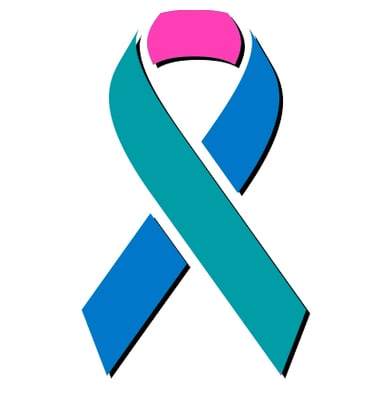 What color ribbon represents Thyroid Cancer?
What color ribbon represents Thyroid Cancer?
Teal, pink, and blue are the colors associated with thyroid cancer.
Blue Teal Pink Ribbon: Quick Facts
-
Ribbon Color: Blue Teal Pink Segmented
-
Pantone Code: 3005C (Blue), 320C (Teal), 806C (Pink)
-
Hex Code: #0077C8 (Blue), #009CA6 (Teal), #FF3EB5 (Pink)
-
Rapidwristbands Color: Blue Teal Pink Segmented (Contact Customer Service to order)
Thyroid Cancer Awareness Month
September is Thyroid Cancer Awareness Month.
During the month, people wear the split Thyroid Cancer Awareness ribbon or wristbands.
You can do any of these things throughout the year, but during September it will be particularly effective. Add an awareness message to your email signature.
Lastly, donate your time or money to organizations that do research, or raise money to support research.
Organizations like the American Cancer Society and National Cancer Institute play pivotal roles in research and support.
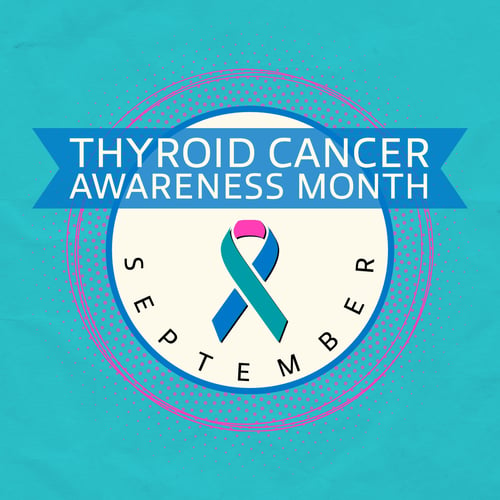
Cancer Awareness Initiatives
Promoting cancer awareness isn't just constrained to that particular cancer awareness month.
Cancer survivors need your support year-round, and one of the easiest ways to provide that support is through the use of cancer ribbons and wristbands.
There are dozens of cancer ribbon colors, and that's why we've created a series of blogs examining each one. Whether it's a well-known common cancer such as breast cancer (represented by a pink ribbon) or a disease with less public awareness such as pancreatic cancer (the purple ribbon) or colorectal cancer (dark blue), there's an awareness ribbon and color out there for it.
Did you know the black ribbon is used for skin cancer awareness month? Or that prostate (represented by a light blue ribbon) is the second most common cancer in the US?
Wristbands can also serve as a physical and persistent reminder. Alongside these bands, sharing personal stories and promoting pink and purple ribbons for general cancer awareness can make a profound difference.
Shining a spotlight on a lesser-known cancer
Though not as high-profile as other cancers, thyroid cancer demands our attention and understanding. Every effort, no matter the magnitude, pushes us closer to a world better informed and more empathetic.
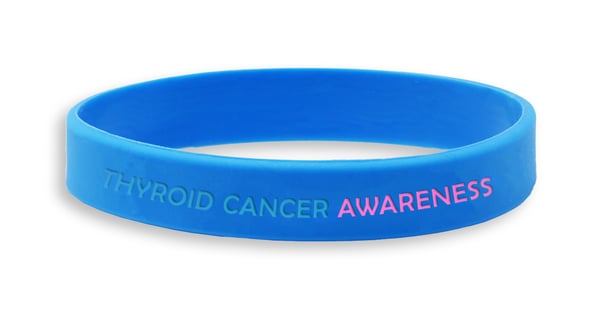
Sources:
1. https://www.cancer.org/cancer/thyroid-cancer/causes-risks-prevention/risk-factors.html
3. https://www.mayoclinic.org/diseases-conditions/thyroid-cancer/symptoms-causes/syc-20354161
4. https://my.clevelandclinic.org/health/diseases/12210-thyroid-cancer/management-and-treatment
Infographic: https://www.medindia.net/health-infographics/thyroid-cancer.htm
.png)
.png)
.png)


.png)
.png)

.png)
.png)
.png)
.png)
.png)
.png)
.png)
.png)
.png)
.png)
.png)
